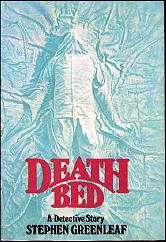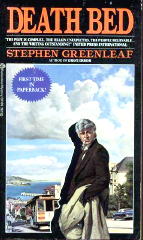Sat 19 Sep 2015

STEPHEN GREENLEAF – Death Bed. Dial Press, hardcover, 1980. Ballantine, paperback, 1982. Bantam Crimeline, paperback, 1991.
If you’re a private eye fan and you haven’t yet discovered Stephen Greenleaf, then you’ve been missing one of the bright new names in the field. This is only his second book, and already, for all intents and purposes, he has the formula down to perfection.
Greenleaf’s detective is an ex-lawyer named John Marshall Tanner. The scene is San Francisco, home of more private detectives per capita than any other city in the nation, Los Angeles notwithstanding. Tanner’s client is a rich man who is dying of cancer and who wants his alienated son found. Tanner is hired to find him.
The son, however, is a leftover radical from the stormy Berkeley days of the sixties. He is also wanted by the police. The amount of money he would inherit is sizable, and naturally there are those who would also like their hands on it, which they would, were Tanner to fail.
Tanner also has other irons in the fire. A crusading reporter who prefers to work incognito has come up missing, and the police are worried about an unknown underground organization rumored to be buying up all the guns and ammunition on the black market that they can. Tanner has to do some fancy footwork just to remember what case he’s working on at what time.

I mentioned “formula” above. As any experienced PI enthusiast will immediately recognize, all these cases that Tanner finds himself working on are not separate, but one. As far as PI fans are concerned, however, the more complex the plot is, the happier they are, and Greenleaf has enough twists involved in this labyrinthine maze of conflicting emotions and desires to satisfy anyone’s cravings.
The combination of mood and atmosphere is black: dark, ugly, and violent. The writing is solid — if anything, perhaps a little too solid. Take this passage from page 202, for example. It’s fairly typical:
It’s a well-written, picturesque paragraph-sentence, but it’s not one entirely conducive to speed-reading. It runs — if you’ll forgive me — counter-commuter-wise to the flow of the story, if you see what I mean.
All the ingredients of a successful private eye series are here. For my own part, I wish I didn’t have this underlying feeling that everything — what have you: the mood, the complex plot, the overly elaborate set of metaphors and similies — wasn’t just a trifle too calculated.
Which is to say, if only I could get it into words, I continually felt as though I were being forced to admire all the great scenery going by — without ever being able to sit back and enjoy the ride.
Rating: B plus.
NOTE: This book was reviewed earlier on this blog by Marcia Muller. Check it out here.
September 21st, 2015 at 12:06 am
While I am a huge fan of Greenleaf and Tanner (hard not to like a pi named after a Supreme Court justice) you hit a nail squarely in regard to the remark that his prose seemed calculated. Greenleaf struck me a little like the worst of Ross Macdonald in that at times I was too aware of the author’s intelligence and taste rather than the characters.
I think it was a fair criticism from Chandler about Macdonald and Archer at times and a fair one of Greenleaf and Tanner.
Obviously it was not a big problem with me, but it is an observation I made myself reading his work. I always felt he was just working a shade too hard at what should have ideally flowed naturally, crafting a sentence that perhaps should have felt more natural.